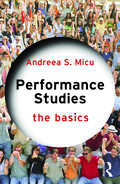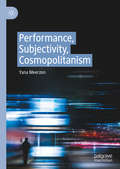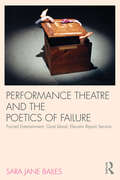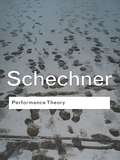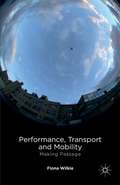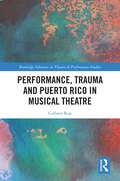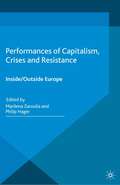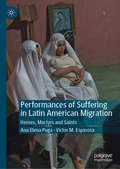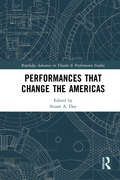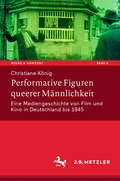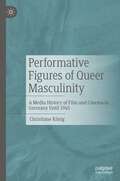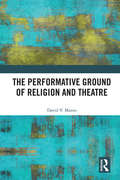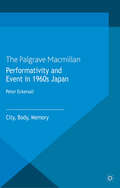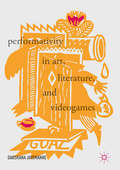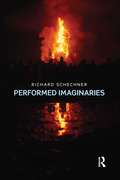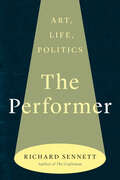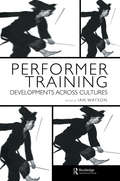- Table View
- List View
Performance Studies: The Basics (The Basics)
by Andreea S. MicuPerformance Studies: The Basics offers an overview of the multiple, often overlapping definitions of performance, from performance art, performance as everyday life, and rituals, to the performative dimensions of identity, such as gender, race and sexuality. This book defines the interdisciplinary field of performance studies as it has evolved over the past four decades at the intersection of academic scholarship and artistic and activist practices. It discusses performance as an important means of communicating and of understanding the world, highlighting its intersections with critical theory and arguing for the importance of performance in the study of human behaviour and social practices. Complete with a helpful glossary and bibliography, as well as suggestions for further reading, this book is an ideal starting point for those studying performance studies as well as for general readers with an interest in the subject.
Performance Studies: The Basics (The Basics)
by Andreea S. MicuPerformance Studies: The Basics offers an overview of the multiple, often overlapping definitions of performance, from performance art, performance as everyday life, and rituals, to the performative dimensions of identity, such as gender, race and sexuality. This book defines the interdisciplinary field of performance studies as it has evolved over the past four decades at the intersection of academic scholarship and artistic and activist practices. It discusses performance as an important means of communicating and of understanding the world, highlighting its intersections with critical theory and arguing for the importance of performance in the study of human behaviour and social practices. Complete with a helpful glossary and bibliography, as well as suggestions for further reading, this book is an ideal starting point for those studying performance studies as well as for general readers with an interest in the subject.
Performance, Subjectivity, Cosmopolitanism
by Yana MeerzonThis book looks at the connection between contemporary theatre practices and cosmopolitanism, a philosophical condition of social behaviour based on our responsibility, respect, and healthy curiosity to the other. Advocating for cosmopolitanism has become a necessity in a world defined by global wars, mass migration, and rise of nationalism. Using empathy, affect, and telling personal stories of displacement through embodied encounter between the actor and their audience, performance arts can serve as a training ground for this social behavior. In the centre of this encounter is a new cosmopolitan: a person of divided origins and cultural heritage, someone who speaks many languages and claims different countries as their place of belonging. The book examines how European and North American theatres stage this divided subjectivity: both from within, the way we tell stories about ourselves to others, and from without, through the stories the others tell about us.
Performance Theatre and the Poetics of Failure
by Sara Jane BailesWhat does it mean to "fail" in performance? How might staging failure reveal theatre’s potential to expand our understanding of social, political and everyday reality? What can we learn from performances that expose and then celebrate their ability to fail? In Performance Theatre and the Poetics of Failure, Sara Jane Bailes begins with Samuel Beckett and considers failure in performance as a hopeful strategy. She examines the work of internationally acclaimed UK and US experimental theatre companies Forced Entertainment, Goat Island and Elevator Repair Service, addressing accepted narratives about artistic and cultural value in contemporary theatre-making. Her discussion draws on examples where misfire, the accidental and the intentionally amateur challenge our perception of skill and virtuosity in such diverse modes of performance as slapstick and punk. Detailed rehearsal and performance analysis are used to engage theory and contextualise practice, extending the dialogue between theatre arts, live art and postmodern dance. The result is a critical account of performance theatre that offers essential reading for practitioners, scholars and students of Performance, Theatre and Dance Studies.
Performance Theatre and the Poetics of Failure
by Sara Jane BailesWhat does it mean to "fail" in performance? How might staging failure reveal theatre’s potential to expand our understanding of social, political and everyday reality? What can we learn from performances that expose and then celebrate their ability to fail? In Performance Theatre and the Poetics of Failure, Sara Jane Bailes begins with Samuel Beckett and considers failure in performance as a hopeful strategy. She examines the work of internationally acclaimed UK and US experimental theatre companies Forced Entertainment, Goat Island and Elevator Repair Service, addressing accepted narratives about artistic and cultural value in contemporary theatre-making. Her discussion draws on examples where misfire, the accidental and the intentionally amateur challenge our perception of skill and virtuosity in such diverse modes of performance as slapstick and punk. Detailed rehearsal and performance analysis are used to engage theory and contextualise practice, extending the dialogue between theatre arts, live art and postmodern dance. The result is a critical account of performance theatre that offers essential reading for practitioners, scholars and students of Performance, Theatre and Dance Studies.
Performance Theory
by Richard SchechnerFew have had quite as much impact in both the academy and in the world of theatre production as Richard Schechner. For more than four decades his work has challenged conventional definitions of theatre, ritual and performance. When this seminal collection first appeared, Schechner's approach was not only novel, it was revolutionary: drama is not just something that occurs on stage, but something that happens in everyday life, full of meaning, and on many different levels. Within these pages he examines the connections between Western and non-Western cultures, theatre and dance, anthropology, ritual, performance in everyday life, rites of passage, play, psychotherapy and shamanism.
Performance Theory
by Richard SchechnerFew have had quite as much impact in both the academy and in the world of theatre production as Richard Schechner. For more than four decades his work has challenged conventional definitions of theatre, ritual and performance. When this seminal collection first appeared, Schechner's approach was not only novel, it was revolutionary: drama is not just something that occurs on stage, but something that happens in everyday life, full of meaning, and on many different levels. Within these pages he examines the connections between Western and non-Western cultures, theatre and dance, anthropology, ritual, performance in everyday life, rites of passage, play, psychotherapy and shamanism.
Performance, Transport and Mobility: Making Passage
by F. WilkiePerformance, Transport and Mobility is an investigation into how performance moves, how it engages with ideas about movement, and how it potentially shapes our experiences of movement. Using a critical framework drawn from the 'mobility turn' in the social sciences, it analyses a range of performances that explore what it means to be in transit.
Performance, Trauma and Puerto Rico in Musical Theatre (Routledge Advances in Theatre & Performance Studies)
by Colleen RuaThis study positions four musicals and their associated artists as mobilizers of defiant joy in relation to trauma and healing in Puerto Rico. The book argues that the historical trajectory of these musicals has formed a canon of works that have reiterated, resisted or transformed experiences of trauma through linguistic, ritual, and geographic interventions. These traumas may be disaster-related, migrant-related, colonial or patriarchal. Bilingualism and translation, ritual action, and geographic space engage moments of trauma (natural disaster, incarceration, death) and healing (community celebration, grieving, emancipation) in these works. The musicals considered are West Side Story (1957, 2009, 2019); The Capeman (1998); In the Heights (2008); and Hamilton (2015). Central to this argument is that each of the musicals discussed is tied to Puerto Rico, either through the representation of Puerto Rican characters and stories, or through the Puerto Rican positionality of its creators. The author moves beyond the musicals to consider Lin-Manuel Miranda as an embodied site of healing, that has been met with controversy, as well as posthurricane Maria relief efforts led by Miranda on the island and from a distance. In each of the works discussed, acts of belonging shape notions of survivorship and witness. This book also opens a dialogue between these musicals and the work of island-based artists Y no había luz, that has served as sites of first response to disaster. This book will be of interest to students and scholars in Latinx Theatre, Musical Theatre and Translation studies.
Performance, Trauma and Puerto Rico in Musical Theatre (Routledge Advances in Theatre & Performance Studies)
by Colleen RuaThis study positions four musicals and their associated artists as mobilizers of defiant joy in relation to trauma and healing in Puerto Rico. The book argues that the historical trajectory of these musicals has formed a canon of works that have reiterated, resisted or transformed experiences of trauma through linguistic, ritual, and geographic interventions. These traumas may be disaster-related, migrant-related, colonial or patriarchal. Bilingualism and translation, ritual action, and geographic space engage moments of trauma (natural disaster, incarceration, death) and healing (community celebration, grieving, emancipation) in these works. The musicals considered are West Side Story (1957, 2009, 2019); The Capeman (1998); In the Heights (2008); and Hamilton (2015). Central to this argument is that each of the musicals discussed is tied to Puerto Rico, either through the representation of Puerto Rican characters and stories, or through the Puerto Rican positionality of its creators. The author moves beyond the musicals to consider Lin-Manuel Miranda as an embodied site of healing, that has been met with controversy, as well as posthurricane Maria relief efforts led by Miranda on the island and from a distance. In each of the works discussed, acts of belonging shape notions of survivorship and witness. This book also opens a dialogue between these musicals and the work of island-based artists Y no había luz, that has served as sites of first response to disaster. This book will be of interest to students and scholars in Latinx Theatre, Musical Theatre and Translation studies.
Performances of Capitalism, Crises and Resistance: Inside/Outside Europe
by Marilena Zaroulia Philip HagerDiscussing crises through diverse examples, including the UK's National Theatre, public art installations, Occupy LSX, repatriation ceremonies and performances of the everyday, this book asks how performance captures and resists what is considered (politically, ideologically, culturally or socially) 'inside' or 'outside' Europe.
Performances of Suffering in Latin American Migration: Heroes, Martyrs and Saints
by Ana Elena Puga Víctor M. EspinosaThis book questions the reliance on melodrama and spectacle in social performances and cultural productions by and about migrants from Mexico and Central America to the United States. Focusing on archetypal characters with nineteenth-century roots that recur in the twentieth- and twenty-first centuries – heroic saviors, saintly mothers and struggling fathers, martyred children and rebellious youth – it shows how theater practitioners, filmmakers, visual artists, advocates, activists, journalists, and others who want to help migrants often create migrant melodramas, performances that depict their heroes as virtuous victims at the mercy of evil villains. In order to gain respect for the human rights that are supposedly already theirs on paper and participate in a global market that trades in performances of suffering, migrants themselves sometimes accept the roles into which they are cast, or even cast themselves. Some express their suffering publicly, often on demand. Others find ways to twist, parody, resist, or reject migrant melodrama.
Performances that Change the Americas (Routledge Advances in Theatre & Performance Studies)
by Stuart A. DayThis collection of essays explores activist performances, all connected to theater or performance training, that have changed the Americas—from Canada to the Southern Cone. Through the study of specific examples from numerous countries, the authors of this volume demonstrate a crucial, shared outlook: they affirm that ordinary people change the direction of history through performance. This project offers concrete, compelling cases that emulate the modus operandi of people like historian Howard Zinn. In the same spirit, the chapters treat marginal groups whose stories underscore the potentially unstoppable and transformative power of united, embodied voices. This book will be of great interest to students and scholars of theatre, performance, art and politics.
Performances that Change the Americas (Routledge Advances in Theatre & Performance Studies)
by Stuart Alexander DayThis collection of essays explores activist performances, all connected to theater or performance training, that have changed the Americas—from Canada to the Southern Cone. Through the study of specific examples from numerous countries, the authors of this volume demonstrate a crucial, shared outlook: they affirm that ordinary people change the direction of history through performance. This project offers concrete, compelling cases that emulate the modus operandi of people like historian Howard Zinn. In the same spirit, the chapters treat marginal groups whose stories underscore the potentially unstoppable and transformative power of united, embodied voices. This book will be of great interest to students and scholars of theatre, performance, art and politics.
Performative Figuren queerer Männlichkeit: Eine Mediengeschichte von Film und Kino in Deutschland bis 1945 (Szene & Horizont. Theaterwissenschaftliche Studien #5)
by Christiane KönigDie medienkulturgeschichtliche Arbeit ist eine deutsche Kino- und Filmgeschichte von den 1890er Jahren bis 1945 mit Fokus auf queere Männlichkeit. Mit medienwissenschaftlichen Ansätzen zeigt die Studie, wie sich das ‚neue Medium’ Film durch performative Wiederaufführungen spektakulärer Elemente aus den Unterhaltungs- und Wissenskulturen des 19. Jahrhunderts konstituiert. Darin werden Körper, Begehren und Identitäten durch Differenzbildungen ständig remodelliert. Männliche Queerness bedeutet hier folglich nicht Repräsentation männlicher Homosexualität. Vielmehr ist sie dynamisches Ergebnis komplexer medialer Prozesse, in Verknüpfung mit Affekten und (Selbst-)Erkenntnissen auf und vor der Leinwand. Aufbauend auf dem queer-feministischen Konzept der queer performativity von Eve K. Sedgwick, erstellt die Autorin ein historisch situiertes Modell, mit dem sie verschiedene Figuren technisch-anthropomorpher queerer Männlichkeit des Mediums Film im ermächtigenden Sinne nachzeichnet. Die anhand von einzelnen Langfilmen herauspräparierten Figuren sind dabei stets mitbedingt durch Veränderungen der assemblage des Kino-Apparats über die Jahrzehnte bis 1945 sowie durch zeitgenössisch aktuelle Aspekte der Geschlechtergeschichte und der Geschichte der Sexualität in Deutschland.
Performative Figures of Queer Masculinity: A Media History of Film and Cinema in Germany Until 1945
by Christiane KönigThis is a German history of cinema and film from the 1890s to 1945 with a focus on queer masculinity. Using media studies approaches, the study shows how film as a new medium is constituted through performative re-enactments of spectacular elements from the entertainment and knowledge cultures of the 19th century. In it, bodies, desires and identities are constantly remodelled through the formation of difference. Therefore, male queerness here does not mean the representation of male homosexuality. Rather, it is the dynamic result of complex medial processes, affects and (self-)knowledge on and off the screen. Building on Eve K. Sedgwick's queer-feminist concept of queer performativity, the author creates a historically situated model with which she traces various figures of technically anthropomorphic queer masculinity in the medium of film in an empowering sense. This book is a translation of an original German 1st edition Performative Figuren queerer Männlichkeit by Christiane König, published by J.B.Metzler, imprint of Springer-Verlag GmbH Germany, part of Springer Nature in 2020. The translation was done with the help of artificial intelligence (machine translation by the service DeepL.com). The author (with the friendly support of Megan Hanson) has subsequently revised the text further in an endeavour to refine the work stylistically. Springer Nature works continuously to further the development of tools for the production of books and on the related technologies to support authors.
The Performative Ground of Religion and Theatre
by David V. MasonReligious practitioners and theatregoers have much in common. So much, in fact, that we can say that religion is often a theatrical phenomenon, and that theatre can be a religious experience. By examining the phenomenology of religion, we can in turn develop a better understanding of the phenomenology of theatre. That is to say, religion can show us the ways in which theatre is not fake. This study explores the overlap of religion and theatre, especially in the crucial area of experience and personal identity. Reconsidering ideas from ancient Greece, premodern India, modern Europe, and the recent century, it argues that religious adherents and theatre audiences are largely, themselves, the mechanisms of their experiences. By examining the development of the philosophy of theatre alongside theories of religious action, this book shows how we need to adjust our views of both. Featuring attention to influential notions from Plato and Aristotle, from the Natyashastra, from Schleiermacher to Sartre, Bourdieu, and Butler, and considering contemporary theories of performance and ritual, this is vital reading for any scholar in religious studies, theatre and performance studies, theology, or philosophy.
The Performative Ground of Religion and Theatre
by David V. MasonReligious practitioners and theatregoers have much in common. So much, in fact, that we can say that religion is often a theatrical phenomenon, and that theatre can be a religious experience. By examining the phenomenology of religion, we can in turn develop a better understanding of the phenomenology of theatre. That is to say, religion can show us the ways in which theatre is not fake. This study explores the overlap of religion and theatre, especially in the crucial area of experience and personal identity. Reconsidering ideas from ancient Greece, premodern India, modern Europe, and the recent century, it argues that religious adherents and theatre audiences are largely, themselves, the mechanisms of their experiences. By examining the development of the philosophy of theatre alongside theories of religious action, this book shows how we need to adjust our views of both. Featuring attention to influential notions from Plato and Aristotle, from the Natyashastra, from Schleiermacher to Sartre, Bourdieu, and Butler, and considering contemporary theories of performance and ritual, this is vital reading for any scholar in religious studies, theatre and performance studies, theology, or philosophy.
Performativity and Event in 1960s Japan: City, Body, Memory
by P. EckersallPerformativity and Event in 1960s Japan considers the artists and events in 1960s Japan. In response to the social upheavals of the 1960s, it shows how art interacted with society in unique and transformational ways, nterweaving arguments about the critical role of performance as an artistic medium and as a social dramaturgy.
Performativity in Art, Literature, and Videogames
by Darshana JayemanneThis book modifies the concept of performativity with media theory in order to build a rigorous method for analyzing videogame performances. Beginning with an interdisciplinary exploration of performative motifs in Western art and literary history, the book shows the importance of framing devices in orienting audiences’ experience of art. The frame, as a site of paradox, links the book’s discussion of theory with close readings of texts, which include artworks, books and videogames. The resulting method is interdisciplinary in scope and will be of use to researchers interested in the performative aspects of gaming, art, digital storytelling and nonlinear narrative.
Performativity in Art, Literature, and Videogames
by Darshana JayemanneThis book modifies the concept of performativity with media theory in order to build a rigorous method for analyzing videogame performances. Beginning with an interdisciplinary exploration of performative motifs in Western art and literary history, the book shows the importance of framing devices in orienting audiences’ experience of art. The frame, as a site of paradox, links the book’s discussion of theory with close readings of texts, which include artworks, books and videogames. The resulting method is interdisciplinary in scope and will be of use to researchers interested in the performative aspects of gaming, art, digital storytelling and nonlinear narrative.
Performed Imaginaries
by Richard SchechnerIn this collection of essays, performance studies scholar and artist Richard Schechner brings his unique perspective to bear upon some of the key themes of society in the 21st century. Schechner connects the avantgarde and terror, the counter-cultural movement of the 1960s/70s and the Occupy movement; self-wounding art, popular culture, and ritual; the Ramlila cycle play of India and the way imagination structures reality; the corporate world and conservative artists. Schechner asks artists to redeploy Nehru's Third World as a movement not of nations but of like-minded culture workers who must propose counter-performances to war, violence, and the globalized corporate empire. With characteristic brio, Schechner urges us to play for keeps. "Playing deeply is a way of finding and embodying new knowledge", he writes. Performed Imaginaries ranges through some of the key moves within Schechner’s oeuvre, and challenges today’s experimental artists, activists, and scholars to generate a new, third world of performance.
Performed Imaginaries
by Richard SchechnerIn this collection of essays, performance studies scholar and artist Richard Schechner brings his unique perspective to bear upon some of the key themes of society in the 21st century. Schechner connects the avantgarde and terror, the counter-cultural movement of the 1960s/70s and the Occupy movement; self-wounding art, popular culture, and ritual; the Ramlila cycle play of India and the way imagination structures reality; the corporate world and conservative artists. Schechner asks artists to redeploy Nehru's Third World as a movement not of nations but of like-minded culture workers who must propose counter-performances to war, violence, and the globalized corporate empire. With characteristic brio, Schechner urges us to play for keeps. "Playing deeply is a way of finding and embodying new knowledge", he writes. Performed Imaginaries ranges through some of the key moves within Schechner’s oeuvre, and challenges today’s experimental artists, activists, and scholars to generate a new, third world of performance.
The Performer: Art, Life, Politics
by Richard SennettAn acclaimed sociologist’s exploration of the connections among performances in life, art, and politics In The Performer, Richard Sennett explores the relations between performing in art (particularly music), politics, and everyday experience. It focuses on the bodily and physical dimensions of performing, rather than on words. Sennett is particularly attuned to the ways in which the rituals of ordinary life are performances. The book draws on history and sociology, and more personally on the author’s early career as a professional cellist, as well as on his later work as a city planner and social thinker. It traces the evolution of performing spaces in the city; the emergence of actors, musicians, and dancers as independent artists; the inequality between performer and spectator; the uneasy relations between artistic creation and social and religious ritual; the uses and abuses of acting by politicians. The Janus-faced art of performing is both destructive and civilizing.
Performer Training: Developments Across Cultures
by Ian WatsonPerformer Training is an examination of how actors are trained in different cultures. Beginning with studies of mainstream training in countries such as Poland, Australia, Germany, and the United States, subsequent studies survey: · Some of Asia's traditional training methods and recent experiments in performer training · Eugenio Barba's training methods · Jerzy Grotowski's most recent investigations · The Japanese American NOHO companies attempts at integrating Kyogen into the works of Samuel Beckett · Descriptions of the training methods developed by Tadashi Suzuki and Anne Bogart at their Saratoga International Theatre Institute · Recent efforts to re-examine the role and scope of training, like Britain's International Workshop Festival and the European League of Institutes of Arts masterclasses · The reformulation of the use of emotions in performer training known as Alba Emoting.
